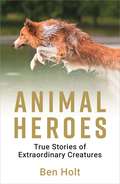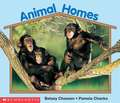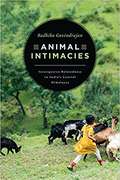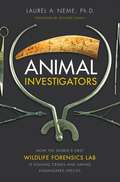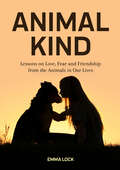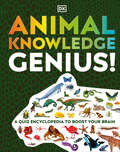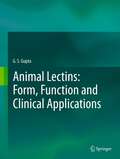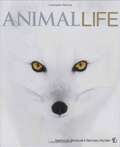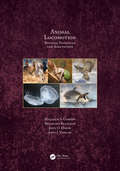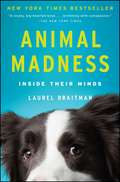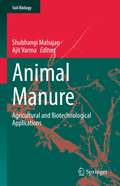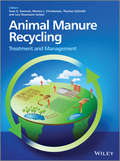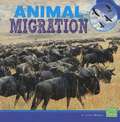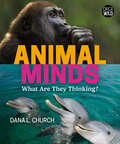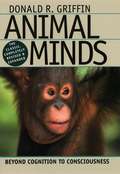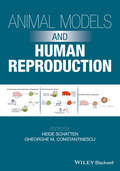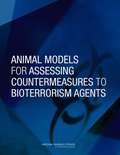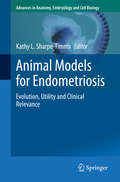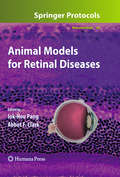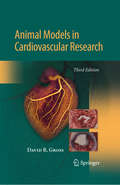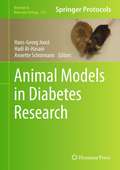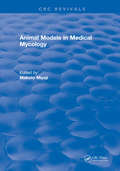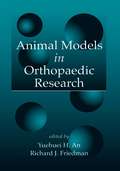- Table View
- List View
Animal Heroes: True Stories of Extraordinary Creatures
by Ben HoltAnimal Heroes contains some of the most extraordinary true tales of bravery across the natural world, from domestic pets to wild animals, proving that when it comes to facing danger there’s more to them than meets the eye.
Animal Heroes: True Stories of Extraordinary Creatures
by Ben HoltAnimal Heroes contains some of the most extraordinary true tales of bravery across the natural world, from domestic pets to wild animals, proving that when it comes to facing danger there’s more to them than meets the eye.
Animal Homes
by Bestey Chessen Pamela ChankoSimple text describe the habitats of different animals.
Animal Intimacies: Interspecies Relatedness in India's Central Himalayas
by Radhika GovindrajanWhat does it mean to live and die in relation to other animals? Animal Intimacies posits this central question alongside the intimate—and intense—moments of care, kinship, violence, politics, indifference, and desire that occur between human and non-human animals. Built on extensive ethnographic fieldwork in the mountain villages of India’s Central Himalayas, Radhika Govindrajan’s book explores the number of ways that human and animal interact to cultivate relationships as interconnected, related beings. Whether it is through the study of the affect and ethics of ritual animal sacrifice, analysis of the right-wing political project of cow-protection, or examination of villagers’ talk about bears who abduct women and have sex with them, Govindrajan illustrates that multispecies relatedness relies on both difference and ineffable affinity between animals. Animal Intimacies breaks substantial new ground in animal studies, and Govindrajan’s detailed portrait of the social, political and religious life of the region will be of interest to cultural anthropologists and scholars of South Asia as well.
Animal Investigators
by Laurel A Neme Richard LeakeyInside the Clark R. Bavin U.S. Fish and Wildlife Service Forensics Laboratory lies a rarely seen world, a CSI for wildlife, where a walk-in freezer contains carcasses and animal parts awaiting necropsies (animal autopsies); shelves and drawers hold pills, rugs, carvings, and countless other products made from parts of endangered animals; and a dedicated group of forensic scientists is responsible for victims from thirty thousand animal species. Accomplished environmental journalist Laurel A. Neme goes behind the scenes at the wildlife forensics lab -- the only crime lab of its kind -- to reveal how its forensic scientists and the agents of the U.S. Fish and Wildlife Service are working to investigate wildlife crimes, protect endangered species, and stem illegal wildlife trafficking, the third largest illegal trade in the world. In three fascinating cases -- headless walrus washed up on the shores of Alaska, black bears killed for the healing powers of their gallbladders, and gorgeous feathered headdresses secretly shipped to the United States from the Amazon -- Neme traces the USFWS's daring undercover investigations and how the scientists' innovative forensic techniques provide conclusive evidence of a crime. Throughout, she underscores the staggering international scope of the supply and demand for wildlife and animal parts. Filled with the suspense and thrilling detail of a crime novel yet driven by the all-too-real drama of a small band of scientists and investigators battling a lucrative, high-stakes underground industry, Animal Investigators is an engrossing account of crime and cutting-edge science.
Animal Kind: Lessons on Love, Fear and Friendship from the Animals in Our Lives
by Emma LockTrue stories of therapy, companionship, recovery, and other good things animals bring to our lives—plus photos and facts on a variety of species.In Animal Kind, popular YouTuber Emma Lock of YouTube fame shares stories of the incredible ways that animals keep us healthy and happy, physically and mentally. You’ll be inspired by tales of remarkable recovery, from vision-impaired individuals who have gained independence with the help of seeing-eye dogs, to the woman who found new life as an equestrian champion after an arm amputation.The stories in Animal Kind feature an array of relationships that may surprise you. Even wild animals like snakes and raccoons have been known to offer life-changing companionship. With each story, you’ll learn fun facts about the featured species and hear from the people who love them. You’ll also hear the never-before-told story of how animals changed Emma’s own life for good.
Animal Knowledge Genius: A Quiz Encyclopedia to Boost Your Brain (DK Knowledge Genius)
by DKBlow the minds of your friends and family with your animal knowledge. This brilliant nature quiz book is suited for hours of family fun! Do you know the difference between a great white shark and a giant manta ray? Can you spot the difference between a dung beetle and a tiger beetle? Challenge yourself and the family to this brain-busting nature challenge! In this exciting family activity book, you&’ll find: • &“Reference&” spreads which introduce a topic and give all the essential info. • &“Quiz&” pages, packed with pictures to pore over, put your knowledge to the test. • &“Test Yourself&” panels across three levels of difficulty — starter, challenger and genius. • A fun fact with every image gives a clue. • Answers appear upside down on the page. This stunning visual encyclopedia of animal knowledge is packed with hundreds of fantastic facts. It&’s an irresistibly interactive kids book that will have you challenging yourself and the family over and over again. This entertaining general knowledge book for kids will test your brainpower and challenge you to learn so much more. Can you complete all these levels of difficulty as the challenge gets harder? Packed with more than 60 topics across the animal world and eye-popping images, this animal activity book is excellent for brain training and makes learning way more fun. It&’s perfect for children ages 9-12, or geniuses of all ages. Look out for more fun family quiz books in this series from DK. Put your general knowledge skills to the test and take on the Knowledge Genius! brain-busting challenge!
Animal Lectins: Form, Function And Clinical Applications
by Rajesh K. Gupta Anita Gupta G. S. GuptaAnimal Lectins: Form, Function and Clinical Applications presents up-to-date knowledge of animal lectins. Detailed descriptions on biological activities, tissue and/or subcellular distribution, molecular structure, gene organization, possible functions, clinical applications, lectin-ligand interactions and their intervention for therapeutic purposes are provided. The recently discovered C-type lectins as well as further novel super-families of this group of molecules are described in detail. Furthermore, the clinical significance of animal lectins in inflammatory diseases, defects of immune defense and autoimmunity are described and their application as drugs and therapeutic targets is discussed. With the increasing interest in lectins in biomedical research and their therapeutic applications, this book on animal lectins and associated proteins is a must have for researchers in the area.
Animal Life: Secrets of the Animal World Revealed
by Charlotte Uhlenbroek American Museum of Natural HistoryIf you think that watching all the nature programs on television qualifies you as an expert on the subject, think again! Do you really know what makes animals tick? Here are the answers, portrayed in stunning, awe-inspiring action sequences and explained in fascinating, in-depth prose. <p><p>Thematically arranged by behavior trait, Animal Life explores and explains every aspect of animal behavior, including courtship rituals and sex lives, family relationships and defense mechanisms, hunting techniques and feeding habits. Side panels explore some of the field research on animal behavior and explain important conservation issues. The introductory chapters on the Animal Kingdom and on animal anatomy help explain how different animals have evolved and adapted to their environments, adaptations that may be relevant to particular behaviors. <p><p>Destined to be the ultimate authority on animal behavior, this book also looks at key behavioral concepts such as how animals learn to behave and the role of instinct in the learning process. <p><p>AUTHOR BIO: Charlotte Uhlenbroek, Ph.D. spent four years in the forests of Gombe, Tanzania, completing her doctorate in chimpanzee communication under the auspices of world-famous Jane Goodall. Uhlenbroek is an accomplished broadcaster, appearing in many prestigious documentaries produced by the BBC Wildlife Unit, including Talking with Animals (2002) on communications of creatures as diverse as cuttlefish and wolves, Jungle on the world's rain forests, and the 20-part series Safari School (2007). She has published two books to accompany these series, Talking with Animals and Jungle, both of which are now out of print.
Animal Locomotion: Physical Principles and Adaptations
by Malcolm S. Gordon Reinhard Blickhan John O. Dabiri John J. VidelerAnimal Locomotion: Physical Principles and Adaptations is a professional-level, state of the art review and reference summarizing the current understanding of macroscopic metazoan animal movement. The comparative biophysics, biomechanics and bioengineering of swimming, flying and terrestrial locomotion are placed in contemporary frameworks of biodiversity, evolutionary process, and modern research methods, including mathematical analysis. The intended primary audience is advanced-level students and researchers primarily interested in and trained in mathematics, physical sciences and engineering. Although not encyclopedic in its coverage, anyone interested in organismal biology, functional morphology, organ systems and ecological physiology, physiological ecology, molecular biology, molecular genetics and systems biology should find this book useful.
Animal Madness: How Anxious Dogs, Compulsive Parrots, and Elephants in Recovery Help Us Understand Ourselves
by Laurel Braitman**“Science Friday” Summer Reading Pick** **Discover magazine Top 5 Summer Reads** **People magazine Best Summer Reads** “A lovely, big-hearted book…brimming with compassion and the tales of the many, many humans who devote their days to making animals well” (The New York Times).Have you ever wondered if your dog might be a bit depressed? How about heartbroken or homesick? Animal Madness takes these questions seriously, exploring the topic of mental health and recovery in the animal kingdom and turning up lessons that Publishers Weekly calls “Illuminating…Braitman’s delightful balance of humor and poignancy brings each case of life….[Animal Madness’s] continuous dose of hope should prove medicinal for humans and animals alike.” Susan Orlean calls Animal Madness “a marvelous, smart, eloquent book—as much about human emotion as it is about animals and their inner lives.” It is “a gem…that can teach us much about the wildness of our own minds” (Psychology Today).
Animal Manure: Agricultural and Biotechnological Applications (Soil Biology #64)
by Shubhangi Mahajan Ajit VarmaThis book covers the basics of animal manure, or animal dung, and highlights its applications in agriculture and biotechnology. The reader is given a comprehensive overview of the different types of animal manure. Although animal manure can cause environmental problems, e.g., when slurry pollutes rivers or burnt dung pollutes air, the book emphasizes the fact that animal dung is by no means a waste product. Animal manure is a valuable organic fertilizer that has a positive impact on soil conditions and helps save on chemical fertilizers. It is also a source of energy and can be either be used as fuel or converted into biogas through methanization. Old-age practices such as the use of dried dung as insulating material, or burnt dung as mosquito repellent are also taken up.With the increasing focus on the UN Sustainable Development Goals (SDGs), this book offers ideas and solutions related to SDG 2 Zero Hunger and SDG 15 Life on Land. The book will not only be an interesting read for students and researchers in the field of agriculture, but will also appeal to scientists working on waste management, organic manure production or in the paper industry.
Animal Manure Recycling
by Morten L. Christensen Sven G. Sommer Thomas Schmidt Lars Stoumann JensenA rapidly changing and expanding livestock and poultry production sector is causing a range of environmental problems on local, regional and global scales. Animal Manure Recycling: Treatment and Management presents an accessible overview of environmentally friendly technologies for managing animal manure more efficiently and in a sustainable manner. The book describes the physical and chemical characteristics of animal manure and microbial processes, featuring detailed examples and case studies showing how this knowledge can be used in practice. Readers are introduced to the sustainable use of animal manure for crop fertilisation and soil amelioration. Environmentally friendly technologies for reducing emissions of ammonia, odour and the greenhouse gases nitrous oxide and methane are presented, and reduction of plant nutrient losses using separation technologies is introduced. Finally and most importantly, the book describes methods to commercialise and transfer knowledge about innovations to end-users.Topics covered include:Regulation of animal manure managementManure organic matter: characteristics and microbial transformationsGreenhouse gas emissions from animal manures and technologies for their reductionTechnologies and logistics for handling, transport and distribution of animal manuresBioenergy productionAnimal manure residue upgrading and nutrient recovery in bio-fertilisersLife cycle assessment of manure management systemsInnovation in animal manure management and recyclingAnimal Manure Recycling: Treatment and Management presents state-of-the-art coverage of the entire animal manure chain, providing practical information for engineers, environmental consultants, academics and advanced students involved in scientific, technical and regulatory issues related to animal manure management.
Animal Migration
by Jeanie Mebane Bernd HeinrichWhy do wildebeests travel 1,800 miles each year? How do salmon find their way back to the stream where they hatched? Migrating animals move in some unique ways. Discover the amazing ways migrating animals get around.
Animal Minds: What Are They Thinking? (Orca Wild #12)
by Dana L. ChurchKey Selling Points This book explores the field of animal cognition and introduces readers to the scientists and the experiments they use to find out how animals think. Deals with STEM themes, including the scientific method, research, experimentation and also women in science. The book goes beyond facts about animals and explores how animals think. It fosters an appreciation of animals at a deep level: they are thinking beings and are individuals, like humans. The author is an expert in this field. She has a PhD in animal cognition and includes interviews with other scientists to help shape the stories.
Animal Minds: Beyond Cognition to Consciousness
by Donald R. GriffinIn Animal Minds, Donald R. Griffin takes us on a guided tour of the recent explosion of scientific research on animal mentality. Are animals consciously aware of anything, or are they merely living machines, incapable of conscious thoughts or emotional feelings? How can we tell? Such questions have long fascinated Griffin, who has been a pioneer at the forefront of research in animal cognition for decades, and is recognized as one of the leading behavioral ecologists of the twentieth century. With this new edition of his classic book, which he has completely revised and updated, Griffin moves beyond considerations of animal cognition to argue that scientists can and should investigate questions of animal consciousness. Using examples from studies of species ranging from chimpanzees and dolphins to birds and honeybees, he demonstrates how communication among animals can serve as a "window" into what animals think and feel, just as human speech and nonverbal communication tell us most of what we know about the thoughts and feelings of other people. Even when they don't communicate about it, animals respond with sometimes surprising versatility to new situations for which neither their genes nor their previous experiences have prepared them, and Griffin discusses what these behaviors can tell us about animal minds. He also reviews the latest research in cognitive neuroscience, which has revealed startling similarities in the neural mechanisms underlying brain functioning in both humans and other animals. Finally, in four chapters greatly expanded for this edition, Griffin considers the latest scientific research on animal consciousness, pro and con, and explores its profound philosophical and ethical implications.
Animal Models and Human Reproduction: Cell and Molecular Approaches with Reference to Human Reproduction
by Gheorghe M. Constantinescu Heide SchattenOur knowledge of reproductive biology has increased enormously in recent years on cellular, molecular, and genetic levels, leading to significant breakthroughs that have directly benefitted in vitro fertilization (IVF) and other assisted reproductive technologies (ART) in humans and animal systems. Animal Models and Human Reproduction presents a comprehensive reference that reflects the latest scientific research being done in human reproductive biology utilizing domestic animal models. Chapters on canine, equine, cow, pig, frog, and mouse models of reproduction reflect frontier research in placental biology, ovarian function and fertility, non-coding RNAs in gametogenesis, oocyte and embryo metabolism, fertilization, cryopreservation, signal transduction pathways, chromatin dynamics, epigenetics, reproductive aging, and inflammation. Chapters on non-human primate models also highlight recent advancements into such issues as human in vitro fertilization (IVF) and assisted reproductive technologies (ART). This book offers animal scientists, reproductive biology scientists, clinicians and practitioners, invaluable insights into a wide range of issues at the forefront of human reproductive health.
Animal Models for Assessing Countermeasures to Bioterrorism Agents
by Committee on Animal Models for Assessing Countermeasures to Bioterrorism AgentsThe Transformational Medical Technologies (TMT) has been a unique component of the U. S. Department of Defense (DoD) medical biodefense efforts since 2006. Its mission is to advance countermeasure research and development in support of the broader goal of the DoD to protect warfighters from emerging infectious diseases and future genetically engineered biological weapons. The TMT, using advanced science and technology approaches, focused on the development of roadspectrum countermeasures that target common host and pathogen pathways or enhance the host's immune response. Many of these pathogens are lethal or cause such debilitating diseases in humans that it is ethically inappropriate to test the efficacy of these countermeasures in human volunteers. In lieu of human participants, these products may be tested in animals and approved for human use under the provisions of the Food and Drug Administration (FDA)'s 2002 Animal Rule. The reliance on animal models for the development and licensure of medical countermeasures against biothreats is challenging for a number of reasons. The ad hoc Committee on Animal Models for Assessing Countermeasures to Bioterrorism Agents prepared a consensus report that would address the challenges stemming from developing and testing medical countermeasures against biothreat agents in animal models. "Animal Models for Assessing Countermeasures to Bioterrorism Agents" evaluates how well the existing TMT-employed or candidate animal models reflect the pathophysiology, clinical picture, and treatment of human disease as related to the agents of interest. The report addresses the process and/or feasibility of developing new animal models for critical biodefense research, placing emphasis on the need for a robust and expeditious validation process in terms of the FDA's Animal Rule. The report also evaluates alternatives to the use of animal models based on the premise of the Three Rs.
Animal Models for Endometriosis: Evolution, Utility and Clinical Relevance (Advances in Anatomy, Embryology and Cell Biology #232)
by Kathy L. Sharpe-TimmsThis new volume of our successful book series Advances in Anatomy, Embryology and Cell Biology focuses on the need for and use of animal models when studying endometriosis. Covering models ranging from rodents to baboons, it explores novel mechanisms involved in the pathophysiology of endometriosis. Topics range from the role of miRNAs and environmental endocrine disrupters to pain and endometriosis-associated subfertility.Estimated to affect up to 10% of women, endometriosis is a widespread and in some cases debilitating disease. While studies on the pathophysiology of the disease and the development of treatments for endometriosis-associated subfertility are called for, acquiring appropriate tissues from women with and without endometriosis in combination with physiologically relevant in vitro and in vivo laboratory models is an essential aspect. However, control subjects with similar ages, living environments and medical histories, besides endometriosis, are hard to find and attaining suitable human reproductive tissues is linked to an ongoing ethical discussion, especially when studying embryos. Laboratory models like rodent and monkey models are therefore needed to fill the research gap and support hypothesis-driven, randomized, controlled experimental design studies. In this book we highlight the latest developments and findings in endometriosis research using animal models. The book was written for scientists, physicians and medical students working in the field of reproductive science, and for women with endometriosis.
Animal Models for Retinal Diseases (Neuromethods #46)
by Iok-Hou Pang Abbot F. ClarkAffecting over a hundred million individuals worldwide, retinal diseases are among the leading causes of irreversible visual impairment and blindness, and appropriate study models, especially animal models, are essential to furthering our understanding of the etiology, pathology, and progression of these endemic diseases. In Animal Models for Retinal Diseases, recognized experts in the field highlight valuable techniques as well as animal models for the prominent retinal diseases in order to aid in the evaluation, development, and improvement of therapeutic strategies. Beginning with an overview of the morphology of the retina, visual behavior, and genetics and genomics approaches for retinal research, the book continues by covering animal models for the research of specific human retinal diseases, e.g., retinal degeneration, age-related macular degeneration, retinopathy of prematurity, diabetic retinopathy, glaucoma, retinal ischemia, and retinal inflammation. As a volume in the successful Neuromethods series, the chapters provide authoritative reviews of the most commonly used approaches in the field. Vital and easy to use, Animal Models for Retinal Diseases serves to support the important future research of ocular investigators, ophthalmologists, and neuroscientists currently delving into this fascinating field of study.
Animal Models in Cardiovascular Research (Developments In Cardiovascular Medicine Ser. #Vol. 153)
by David GrossInterest in the humane and scientifically justifiable use of research animals has intensified since the publication of the 2nd edition of Animal Models in Cardiovascular Research. This completely revised and updated edition will provide information essential to any researcher interested in using animal models for cardiovascular research, or any research which requires normal cardiovascular function. The format and presentation will be changed to make the text more easy to read and use: (1) This edition is in outline format, for ease and utility. (2) The opening chapter includes more information on the cardiovascular effects of post-operative analgesia and will address the recognition of pain behavior in species commonly used in research settings, particularly rats and mice. (3) New edition includes reference material more useful to researchers using transgenic and naturally occurring animal models to dissect these mechanisms.
Animal Models in Diabetes Research (Methods in Molecular Biology #933)
by Hadi Al-Hasani Annette Schürmann Hans-Georg JoostIn recent years, human studies have made enormous contributions towards an understanding of the genetic basis of diabetes mellitus; however, most of the experimentation needed for the invention and testing of novel therapeutic approaches cannot be performed in humans. Thus, there is no alternative to appropriate animal models. In Animal Models in Diabetes Research, expert researchers explore the current status of the most important models and procedures in order to provide a timely resource in experimental diabetology. The first half of the volume serves as a comprehensive overview on our current knowledge of the pathogenesis and pathophysiology of diabetes in animal models through a series of reviews in model strains. The book then continues with vital, established protocols that are employed in the characterization and study of animal models of diabetes. As a volume in the highly successful Methods in Molecular BiologyTM series, this work contains the type of detailed description and key implementation advice necessary to achieve successful results. Authoritative and cutting-edge, Animal Models in Diabetes Research delivers essential content that will be an important resource to advance diabetes research in the years to come.
Animal Models in Medical Mycology
by Makoto MiyajiThe prevalence of antibiotics, corticosteroids, and anticancer or immunosuppressive drugs and the progress of the medical treatments after World War II have saved the lives of many patients attacked by serious diseases and have contributed to the prolongation of the average life span of a human being. However, there still remain some problems to be solved. One of them is that of compromised hosts, which will be treated in this book.
Animal Models in Orthopaedic Research
by Yuehuei H. An Richard J. FriedmanAnimal Models in Orthopaedic Research is a reference book of the major animal models used in the study of orthopaedic conditions and in the in vivo study of biomaterials. Use of animal models provides important knowledge about pathological conditions that can eventually lead to the development of more effective clinical treatment of diseases in bot
